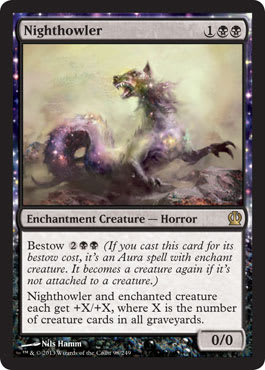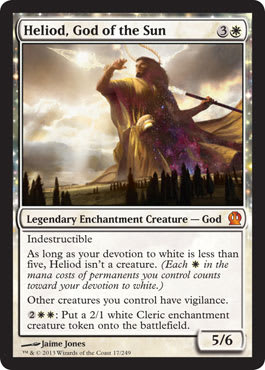With the introduction of Theros, we are also being introduced to some new mechanics. As always, they vary somewhat on the quality of their design mechanically, on their fit flavor-wise, and on their power level.
Bestow
There are fifteen cards in Theros with the bestow mechanic. From a design perspective, it’s basically just combining two card types into one card: creature and enchantment (specifically Aura). This has been done before obviously, notably in the form of artifact creatures. My favorite thing about bestow mechanically is that it gives you two different options with two different casting costs. While increasing options and complexity isn’t ideal for new players, Theros is designed with slightly more advanced players in mind. Not only does having more options reward good play skill, but having more casting cost options helps you adapt to tighter or looser mana draws and to the different points in the game when you might draw the card with bestow. Additionally, if you draw it late in the game and don’t have a target for it, you can still play it as a creature. Having multiple modes and multiple costs increases the chances it will be useful and that you won’t end up being frustrated when you draw it.
From a flavor perspective, being able to bestow a powerful Aura onto a creature represents a gift to that creature from the gods. Since that Aura is also a creature, you’re bestowing your target with the essence of that creature. Killing a creature that has been bestowed with one of these essences summons into being the creature whose essence it was.
Like many mechanics, bestow will probably have a much greater impact in Draft than in Standard. Typically, versatility matters more in Limited than in Constructed. In Constructed, you’d generally rather have a card that’s amazing at doing one specific thing than a card that gives you multiple pretty good options. In addition, the bestow costs are usually high enough to make them rarely relevant in Constructed. This is especially true because of the danger of using all of your mana to play an Aura only to have your target destroyed in response. While some of the cards with bestow are decent creatures for their costs, such as Nighthowler or Boon Satyr, they have the further drawback of being vulnerable to both creature removal and enchantment removal.
Devotion
There are sixteen Theros cards that make use of the devotion mechanic. Devotion is a useful mechanic because the power level varies depending largely on how much you focus your colors. The closer to mono-colored you are, the more powerful it is, and the more colors you are, the weaker it is. This reinforces the basic idea behind having more than one color in the game in the first place. You want to reward color fidelity more than color diversification since having access to more colors is a reward in itself. The other thing I like about it is that it encourages you to play with a lot of permanents, which is generally more fun for everyone.
This is a great mechanic flavor-wise. It represents how faithful you are to the god of that color. The more devoted you are to that god/color, the greater power you’re granted in return. Like bestow, devotion will be much more relevant in Limited than in Constructed. While you are more likely to have a mono-colored deck in Standard than in Draft, permanents generally are more likely to stick around in Limited. In addition, devotion will affect a player’s card and color choices as he or she is drafting. Fanatic of Mogis is intriguing with cards such as Boros Reckoner and Ash Zealot, but red has better choices at 4 mana in Standard. Reverent Hunter is a little intriguing in a green +1/+1 counter deck, and we will at least see Disciple of Phenax seeing a lot of play in Limited.
Gods
Technically, Gods are a new creature type in Theros and not a new mechanic, but they introduce new enough concepts to make them worth discussing here. There are five Gods in Theros, one for each color. Mechanically, I like the idea of a creature that can be turned “on” or “off” by the efforts of either player, especially since it still serves as a useful enchantment either way. Some of the drawback of being multiple card types is ameliorated by the fact that they’re indestructible. Like planeswalkers, it’s very easy for the game to end up revolving around a God when it is played. To assist/avoid in the awakening of a large indestructible creature, the game can become about a desperate struggle to increase/decrease the level of its controller’s devotion, while in the meantime, the God’s controller is benefitting from the enchantment abilities every turn, much like a planeswalker.
These cards are well-designed from a flavor perspective. Each God is an extremely powerful legend that globally helps its devotees, and if enough devotion is shown, the God will even make a personal appearance on behalf of its followers to the regret of those who oppose it. The fact that planeswalkers are legendary isn’t a huge deal because they are both really powerful and relatively fragile. These cards won’t be as good for Constructed because they usually don’t do anything the turn you play them (unlike planeswalkers) and they’re quite bad in multiples. They may see enough Standard play to increase the pressure to play with exile effects. I expect to see Thassa, God of the Sea to be played in Standard, and Erebos, God of the Dead probably will as well.
Heroic
Naturally, we need creatures that are suitably heroic to bestow divine gifts upon. There are eighteen creatures in Theros with the keyword heroic on them. Heroic is a cool mechanic because of its double-edged nature. On one hand, you’re incentivized to target your own creatures so you can receive cool rewards, but on the other hand, this increases your chances of being two-for-oned. Casual players have long enjoyed using enchantments and the like to make super creatures; now more competitive players will be tempted to join in the fun and the risk.
Any story about gods needs heroes, too. It takes courage to take the risk of being heroic, but if you do and you survive, the rewards of the god’s favor are great. Creatures with heroic pair nicely with bestow and various pump spells, but they are much weaker in Constructed than in Limited because there is generally so much more removal in Constructed. The most exciting heroic effects are the ones that immediately regain you the card advantage you are potentially sacrificing, such as Agent of the Fates, Triton Fortune Hunter, and Akroan Crusader.
Monstrosity
What would heroes be without monsters to fight? There are sixteen creatures in Theros that have the monstrosity keyword attached to them. Generally, the creatures with monstrosity range from solid to excellent in size-to-cost ratio. In most cases, they have another special ability even before becoming monstrous. I like this ability in part because it creates more potential decision points and even more because it’s a cool mana sink. Mana-flooded? Guess it’s time to make your monsters hulk out.
Dragons, Hydras, Cyclops, Gorgons, Giants, and even a Kraken, oh my . . . these do seem like the sorts of monsters that fit the theme Wizards is going for here. I also like how just when our hero seems to be gaining the upper hand that the monster being faced can suddenly become even scarier. The monsters seem even scarier than the heroes in this set.
Not surprisingly, I expect we will see more monsters than heroes in Constructed. In most cases, it will have little to do with their monstrous abilities, though. Fleecemane Lion, Nemesis of Mortals, Stormbreath Dragon, and Polukranos, World Eater are all likely to see play in Standard, primarily due to the threat levels they present pre-monstrous. In Limited, I expect for monsters to be a dominant force and for monstrosity to be a game-changing mechanic.
The design team for Theros may not be doing their work from Mount Olympus, but I’m quite impressed with the design work on this set. I think it’s interesting from a mechanical perspective, it works really well from a flavor perspective, and the power level of the new mechanics won’t take over Constructed but won’t be completely irrelevant either. I’m especially looking forward to playing with Gods and monsters in Draft. What about you?



























